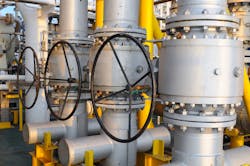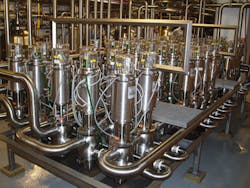Chris Sinutko is the technical product manager for sanitary valves at SPX Flow Technology. He has worked at SPX for four years and is based out of the company’s manufacturing facility in Delavan, Wisconsin. He earned his bachelor’s degree in Mechanical Engineering from the University of Notre Dame. Sinutko can be reached at 262-215-9860 or [email protected].
Q: In your experience, what are the most common reasons for valve failure?
A: Failures in valves can be caused by many factors. Some of the more prominent causes include:
- Wear of the elastomers and/or seat seals over time
- Temperatures or pressures outside the designed operating parameters, especially unexpected pressure spikes in the pipeline
- Foreign or abrasive debris in the pipeline
- Material incompatibility with the product being processes
- Incorrect assembly, installation, or maintenance procedures performed on valve
- Water or foreign debris in plant airline may cause pneumatic actuator failure
Q: Generally speaking, when a valve fails, what is an end user’s appropriate course of action?
A: General guidelines once valve failure has occurred and been identified are as follows:
- Identify location of valve failure (seat, body, actuator, etc.).
- Take necessary troubleshooting steps to further identify root cause or to resolve while the valve is in place.
- Ensure appropriate spare parts are on hand before removing valve from service.
- Remove valve from piping (if necessary) following appropriate procedures, including air and electrical disconnection and lockout tagout.
- Follow proper disassembly and maintenance procedures to resolve issue and reassemble valve.
- Re-install valve into piping with correct air and electrical connections.
- Actuate and test valve to ensure proper function before production startup.
- Monitor valve during initial production run to ensure valve is operating correctly.
Q: Regarding the installation, operation and maintenance of valves, what are some best practices an end user can employ to minimize the occurrence of failure modes?
A: General best practices are:
- Read the instruction manual, attend training sessions, and/or watch videos in order to understand the proper steps of assembly & disassembly, maintenance procedures, and troubleshooting actions.
- Establish a preventive maintenance routine in which common failure parts are replaced before they fail.
Q: With the evolution of digital valve technology and control systems software, technology is playing a more active role in valve reliability with a continued drive toward preventive and predictive maintenance schemes. How do you feel the emergence of more sophisticated technology has and will impact the end user’s capability in regard to valve failure prevention?
A: Digital valve technology allows end users to detect a valve failure almost immediately after it occurs. This gives users the ability to quickly respond to a failure and prevent further damage to the system or product loss. The user could also then use that data to keep a record log of valve alarms or failures to establish a PM schedule, identify potential issues in the system causing repeated valve failure, or determine areas to increase valve life.
Q: One common theme when discussing the use of sophisticated monitoring and control systems is that an overreliance on technology can also lead to unreliability. What are some common pitfalls you see end users encountering when implementing and/or employing a technological approach to valve failure prevention?
A: When implementing a technological or automated control system, plants benefit by reducing the potential for human error, increasing product and personnel safety, and creating a record of equipment activity.
However, end users must not fall into the habit of "screen-reading" in the control room and overrely on the feedback they are receiving. There are typically delays or wide tolerances built into the feedback sensors creating some lag time or delayed responses. This may cause the end user to miss critical pieces of information that could cause equipment failure or give the end user a false-positive indicating that everything is okay, when it is not.
Also, single-seat and double-seat valves tend to have metal-to-metal contact with the seat seals. This means that if a rubber seat seal has failed, fluid could leak past the seat even though the valve is giving the feedback that it is in the closed position and operating correctly.
Therefore, it is crucial to have a balance of automated control system, well-engineered system design, and knowledgeable operators or personnel on the production floor that can detect possible failures or potential issues.
Q: How can an end user effectively balance the use of technological systems and sound engineering practices to optimize the reliability of the valves?
A: Well-designed processes and piping systems using good engineering practices should provide end users with the foundation for successful processing and the reduction of potential failures or issues with valves. Control systems allow end users to automate their process for day-to-day production and identify and record failures so they can be resolved quickly.
Operators and production personnel are able to detect failures or potential issues that the control system has missed or cannot provide feedback on. This will help prevent future failures, increase valve life, and optimize the overall process.
Q: Going forward, what do you see as the key obstacles end users will face in the area of valve failure prevention? What do you see as the key tools/capabilities/best practices end users will be able to arm themselves with to minimize valve failure modes?
A: Looking ahead, I think there may be an emphasis to increase the life of high-wear parts in a valve mainly through different seal materials and seal designs. Also, valve designs are tending to become simpler and more user-friendly to prevent incorrect assembly or maintenance procedures, which could lead to failure. Finally, the control tops and feedback from valves could become more sophisticated with wireless technology that can let users know the status of a valve or a valve failure instantly from anywhere in the plant via a handheld device or a smartphone.


